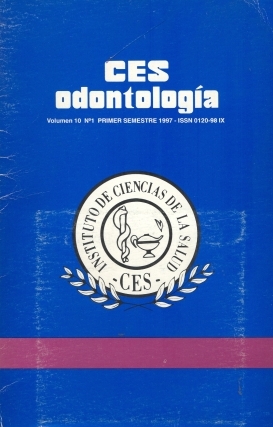CORRELACIÓN ENTRE FUERZA OCLUSAL, PROFUNDIDAD DEL MÚSCULO MASETERO Y ESTRUCTURA DENTOESQUELETOFACIAL
Abstract
Este estudio evaluó la relación de la morfología facial y la estructura dentoesquelética con la razón profundidad muscular y fuerza oclusal en 40 pacientes, 20 normales y 20 con exceso vertical y mordida abierta. Se utilizaron ecografías bilaterales de masetero en contracción y relajación, radiografías cefálicas y P-A y un gnatodinamómetro para medir la fuerza oclusal bilateralmente a nivel de los primeros molares.- El promedio de la profundidad muscular en contracción fue de 11.72 mm para pacientes normales y 11.35 mm para pacientes con exceso vertical, sin diferencia significativa. El promedio de fuerza oclusal fue de 53.99 Kg para normales y de 36.21 Kg para excesivos (diferencia altamente significativa). El coeficiente de correlación entre fuerza oclusal y profundidad muscular en contracción no fue significativo (r menor que 0.25).- El estudio sugiere una alta correlación entre fuerza oclusal y morfología facial, a diferencia de la falta de correlación notoria entre profundidad de masetero y morfología facial. En este grupo de individuos, en el que los pacientes con exceso vertical mostraron alta variabilidad morfológica, la fuerza oclusal y la morfología facial fueron independientes de la profundidad muscular, contrario a los estudios hasta ahora realizados.
ABSTRACT
An evaluation of the relationship between facial morphology and dentoeskeletal structure with muscular thickness and bite force was done. A group of 40 patients, 20 normal and 20 with vertical excess and open bite (10 of which had mandibular length excess) were selected. A bilateral masseter ultrasound imaging technique was used during contraction and resting posture. Profile and P-A radiographs were taken and a transducer was used to measure bite force bilaterally at the level of the first molars. Muscular thickness average during contraction was 11,72 mm. for normal patients and 11,35 mm. for patients with vertical excess, which did not show a significant difference (p>0.05). The average bite force was 53,99 Kg. for normal patients and 36,21 Kg. for others, which indicated a significant difference. The correlation between bite force and muscular thickness in contraction was of no significance (r less than 0.25). This study suggests a high correlation between bite force and facial morphology and no correlation between masseter thickness and facial morphology. In contrast to other studies, individuals with variable vertical excess showed that bite force and the facial morphology were not related to muscular thickness.
Downloads
Downloads
Published
How to Cite
Issue
Section
| Article metrics | |
|---|---|
| Abstract views | |
| Galley vies | |
| PDF Views | |
| HTML views | |
| Other views | |



